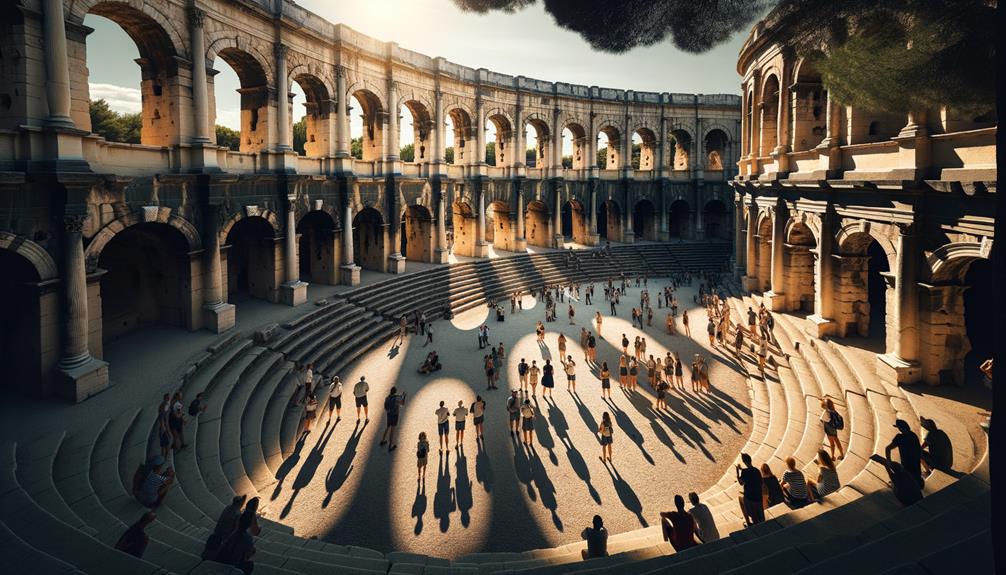Did you know the Nîmes Roman Amphitheatre could hold over 23,000 spectators, all carefully arranged by social rank? Stepping into this ancient structure, I felt a deep connection to the past, imagining the excitement during gladiatorial games. The stone arches and corridors, although worn by time, still showcase Roman engineering skills. Today, the amphitheatre is alive with cultural events that mix the old with the new. As I wandered through its maze-like passages, I couldn't help but wonder about the secrets this grand structure might still hold.
Historical Significance
Standing beside the Nîmes Roman Amphitheatre, I felt an incredible connection to the ancient world. This site, built in the 1st century AD, showcases the power and grandeur of Roman society. Imagining the crowds of over 23,000 Gallo-Romans gathered for entertainment, I felt a chill thinking about gladiators clashing in fierce combat. The air seemed filled with echoes of ancient culture, where the thrill of the games mirrored the might and discipline of the Roman Empire.
Walking through the amphitheatre, I marveled at its ability to transport me back in time. Each stone seemed to tell tales of bravery and brutality. The amphitheatre wasn't just a venue; it was a community hub, highlighting the importance of spectacle in Roman society. It offered a place for the public to witness gladiator fights and animal battles, events meant to display the empire's strength and control.
The Nîmes Roman Amphitheatre is more than just an old structure; it's a vivid reminder of the architectural skill and historical significance that defined an era.
Architectural Features
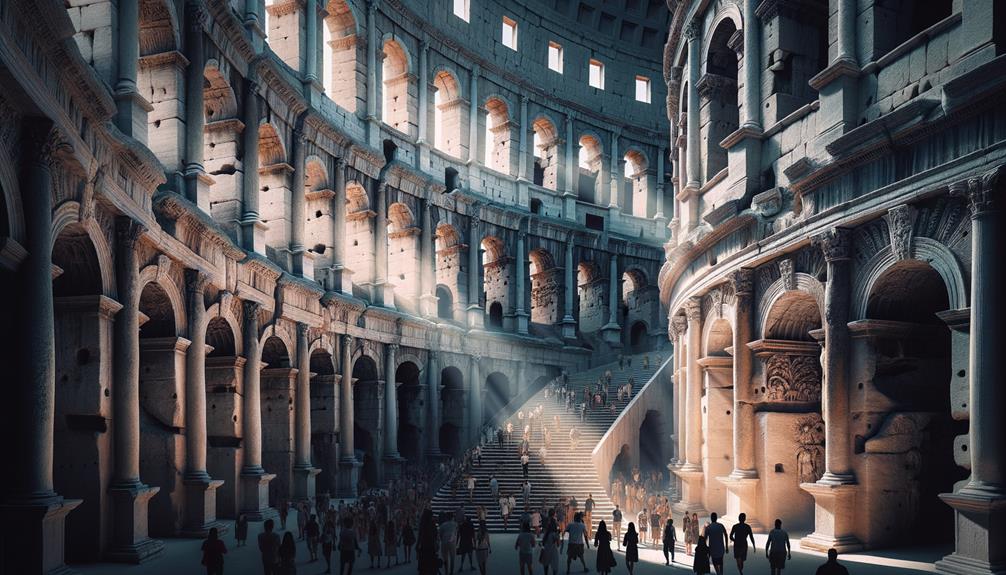
Walking into the Nîmes Roman Amphitheatre, I was immediately struck by its sheer size and the precision of its design. This massive structure stretches 133 meters in length, 101 meters in width, and stands 21 meters high. It features two levels of arcades and 60 spans. As I wandered around, it felt like I could almost hear the echoes of ancient crowds. The numerous staircases and five circular galleries provided excellent circulation, ensuring everyone could move around with ease.
The architectural features of the amphitheatre are truly impressive:
- Over 23,000 Gallo-Romans once filled its seats.
- The seating arrangement, consisting of 34 tiers, was organized by social rank.
- Gladiator combats and animal fights were among the main events held here.
- In the Middle Ages, it served as a fortress, showing its adaptability over time.
- Today, it still hosts events, blending ancient history with modern entertainment.
I was captivated by how the Nîmes Amphitheatre has evolved through the ages. Its Roman architectural brilliance is a testament to the ingenuity and social complexities of the era. The seamless integration of functionality and grandeur left me in awe, making this visit a memorable journey into history.
Seating and Spectators
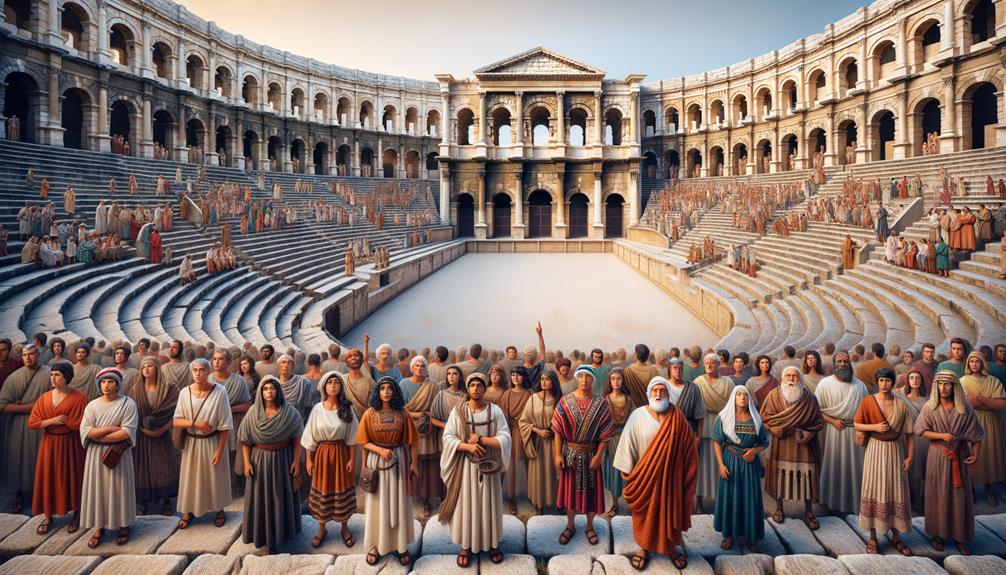
Sitting in the ancient tiers of the Nîmes Roman Amphitheatre, surrounded by its historic atmosphere, was truly incredible. I couldn't help but picture the 23,000 Gallo-Romans who once occupied these seats, each person's spot determined by a complex social hierarchy. The structure was obvious: the elite sat closest to the action, while the common people were higher up.
Walking through the 34 tiers, I was struck by how the seating reflected social order. The best seats had perfect views of the gladiator fights, where warriors battled for their lives and honor. Those lower in rank had to squint to see these intense combats, along with animal fights and public executions, which were both exciting and harsh.
The amphitheatre's energy was almost tangible. I could imagine the crowd's roar as a gladiator won or the collective shock during a dramatic moment. These weren't just stone seats; they were a testament to a society that valued both spectacle and order. The amphitheatre was a grand stage where freedom and fate met in a spectacular fashion.
Historical Transformations
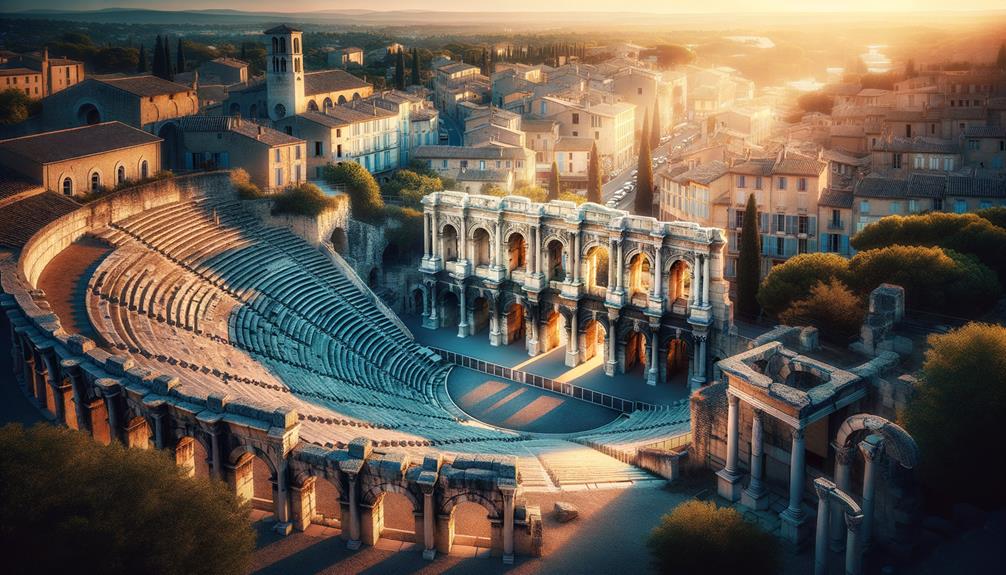
Wandering through the amphitheatre, I imagined how it once transformed into a medieval fortress, a safe haven for the townspeople. In the 18th century, it changed again, with homes, chapels, and even a chateau filling the inner arena. Today, as I walk through its restored arches, I'm amazed by the 19th-century efforts to bring back its Roman grandeur, a testament to its lasting cultural importance.
Fortress in Middle Ages
Imagine walking through the ancient ruins of the Nîmes Roman Amphitheatre and discovering that during the Middle Ages, this grand structure transformed into a formidable fortress, offering protection to residents in times of danger. The very walls that once echoed with the roars of gladiators were repurposed into a stronghold, sheltering the inhabitants of Nîmes from the chaos of medieval life.
The history of this amphitheatre is remarkable. I can almost see the medieval families living within its arches, their daily lives intertwined with Roman architecture. The transformation of this space reveals a unique blend of old and new, showcasing:
- Stone fortifications: Reinforced walls to protect against invaders.
- Private houses: Families living within the ancient structure.
- Chapel additions: Spiritual sanctuaries amid the stone.
- Chateau remnants: Noble residences within the amphitheatre.
- Proof of human ingenuity over centuries: A testament to human ingenuity over centuries.
Wandering through this stronghold, I felt a connection to a time when survival demanded creativity. The Nîmes Roman Amphitheatre is more than a relic; it's a symbol of resilience, embodying the spirit of those who repurposed it to fit their medieval needs.
19th Century Restoration
Restoration efforts in the 19th century brought new life to the Nîmes Roman Amphitheatre, highlighting its grandeur and historical significance. Led by civil engineer Stanislas-Victor Grangent, the restoration began in 1939 to fortify and enhance the structure. Grangent's method combined detailed historical research with modern engineering techniques.
To mimic the original Roman construction methods, wooden arches and bow-tie joints were employed. These careful interventions speak to the dedication to preserving the amphitheatre's authenticity. Walking through the restored arches, I felt a deep connection to the ancient world, as if the stones themselves whispered tales of gladiators and roaring crowds.
| Restoration Element | Description |
|---|---|
| Civil Engineer | Stanislas-Victor Grangent |
| Techniques Used | Wooden arches, bow-tie joints |
| Start Date | 1939 |
The revival of the amphitheatre didn't end in the 19th century. A current 54 million euro project aims to further preserve this iconic structure, with completion expected around 2033. It's amazing to think that such a detailed two-year study preceded these efforts, ensuring every action was both informed and purposeful. This ongoing dedication shows our commitment to keeping history alive, allowing future generations to explore and be inspired by the past.
Modern Usage

Walking into the Nîmes Roman Amphitheatre today, I was amazed at how effortlessly it hosts everything from bullfights to rock concerts. It's incredible to see an ancient structure still drawing in both locals and tourists for a variety of events. This mix of history and modernity shows the amphitheatre's lasting importance to the community.
Diverse Event Hosting
When I walked into the ancient yet lively Nîmes Roman Amphitheatre, the mix of historical grandeur and modern energy was striking. It was clear this place wasn't just a relic of the past but a bustling venue for concerts, bullfights, and various cultural events. The echoes of gladiator combats from long ago seemed to blend with today's diverse activities, creating a unique atmosphere full of life and history.
This amphitheatre, which once held over 23,000 Gallo-Romans, now hosts a wide range of modern events, showing its ability to stay relevant. From where I stood, it was evident that this space continues to be a vibrant cultural center. Here are some of the events you might experience:
- Concerts: Modern music fills the ancient structure, connecting different eras.
- Bullfights: A traditional and controversial event that still attracts many.
- Sports Events: Reflecting the athletic spirit of Roman times, but in modern ways.
- Cultural Festivals: Honoring both historical heritage and contemporary culture.
- Special Exhibitions: Featuring historical artifacts and modern art.
The amphitheatre's current uses breathe new life into its storied walls, showing how historical sites can adapt to today's entertainment while maintaining their cultural importance.
Cultural and Tourist Attraction
Stepping into the Nîmes Roman Amphitheatre today, I was struck by how this ancient monument has woven itself into modern life. Walking through its grand arches, I could feel the weight of its historical significance, a true testament to Roman architecture.
This amphitheatre, once the stage for Gallo-Romans cheering on gladiator battles, is now alive with various events. It hosts everything from thrilling bullfights and vibrant concerts to insightful conferences and exciting sports events. The space's versatility is impressive; it's not just a relic but a dynamic venue that still captures the spirit of ancient Roman culture.
I joined thousands of other visitors, all drawn to this iconic spot. The energy was tangible, and I felt a connection to the countless people who have gathered here over the years. The Nîmes Roman Amphitheatre is more than just stone and history; it's a living example of human creativity and cultural continuity, blending the ancient with the present in a way that feels both timeless and lively.
Visitor Experience
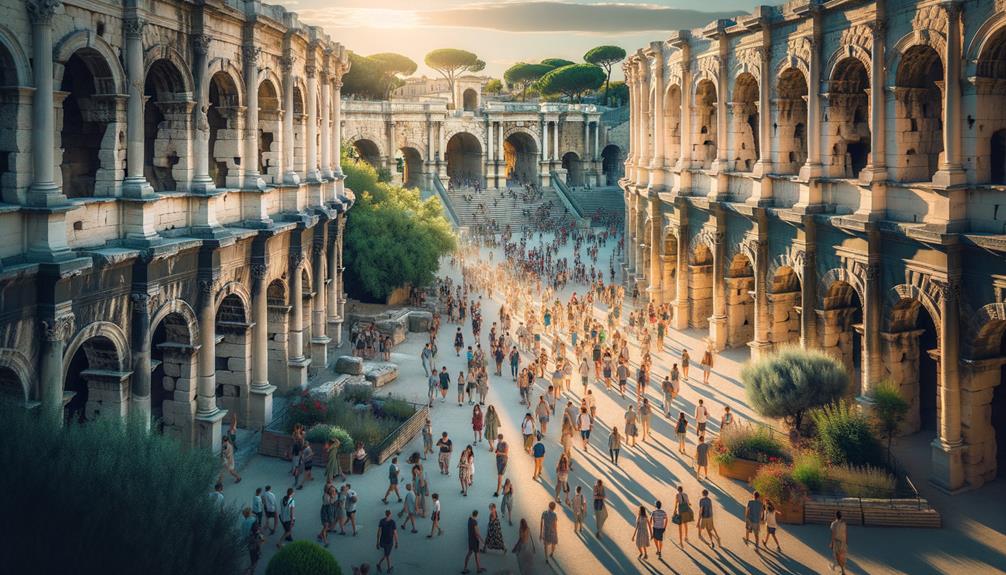
Visiting the Nîmes Roman Amphitheatre, I was immediately awed by its grand ancient architecture and the rich history showcased through guided tours and interactive displays. The stone arches seemed to echo tales of gladiators and cheering crowds as I wandered through its corridors.
The visitor experience was both engaging and enlightening. Here are some highlights:
- The guided tours offered fascinating historical insights, bringing the past to life.
- Climbing to the top, I enjoyed a stunning panoramic view of Nîmes.
- Interactive displays provided a hands-on way to learn about the amphitheatre's storied past.
- Miniature models illustrated the construction progress of this Roman marvel.
- Watching live bullfighting traditions added a unique cultural perspective.
Walking through the amphitheatre, I felt a deep connection to the ancient world. The displays and models gave me a greater appreciation for the Romans' engineering skills. Standing atop the structure and taking in the panoramic view was incredibly liberating. The amphitheatre isn't just a relic; it's an active part of Nîmes' history, seamlessly blending ancient traditions with modern experiences.
Guided Tours and Audio Guides

Guided tours and audio guides at the Nîmes Roman Amphitheatre offer an engaging way to experience ancient history up close. Walking through the amphitheatre, the guided tour deepened my understanding of its historical significance and architectural marvels. The guide's passion was infectious, bringing stories of gladiator battles and ancient events vividly to life.
For those who prefer to wander at their own pace, audio guides are a great alternative. I enjoyed the freedom they provided, letting me spend more time on points of interest and delve deeper into the amphitheatre's cultural heritage.
| Aspect | Experience |
|---|---|
| Historical Insight | Detailed knowledge about the Roman Amphitheatre |
| Architectural Features | Explanations of the structure's design |
| Gladiator Battles | Lively recounts of ancient combat and spectacles |
| Ancient Events | Stories of past happenings |
| Cultural Heritage | Understanding the site's significance |
Interactive displays along the route added another dimension to the experience, making history feel tangible. Whether you choose a guided tour or an audio guide, each option provides a unique view of the Roman Amphitheatre, turning a visit into a journey through time and highlighting both the grandeur and the gritty reality of ancient Roman life.
Ticket Information and Pricing
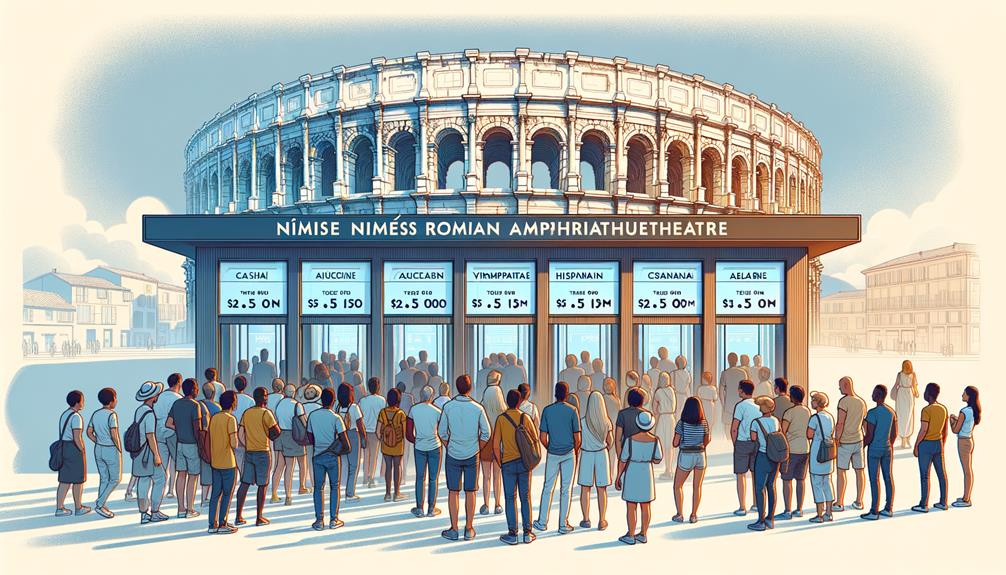
Understanding the ticket details and pricing for the Nîmes Roman Amphitheatre can make planning your visit a breeze. The general admission fee is €13.00, which is quite reasonable for such a historic site. This cost not only covers your entry but also helps with the upkeep of this ancient marvel.
When planning your trip, it's important to check the opening hours, as they vary for each monument in Nîmes. To get the most out of your visit, I suggest pairing your trip to the Roman Amphitheatre with a stop at the Maison Carrée, which is currently being redeveloped to improve the visitor experience.
Here are a few key points to keep in mind:
- Entry Fee: €13.00 for the Roman Amphitheatre.
- Opening Hours: Vary for each monument, so check in advance.
- Free Visits: Available at all Nîmes monuments.
- Accessibility: The amphitheatre is accessible for people with reduced mobility.
- Maison Carrée: Under redevelopment for a better visit.
The accessibility features at the amphitheatre ensure that everyone can enjoy this slice of history. Knowing the logistics ahead of time allows you to fully immerse yourself in the experience when you visit.
Frequently Asked Questions
What Are the Interesting Facts About the Amphitheatre of Nîmes?
Did you know the Nîmes Amphitheatre could hold up to 23,000 spectators? Walking through its ancient arcades, I could feel the history come alive. It's amazing how this place still hosts concerts and bullfights, connecting the past with the present.
What Is the Best Preserved Roman Amphitheater in the World?
The best-preserved Roman amphitheater in the world is the Nîmes Amphitheatre. I've seen it up close, and its sheer size is awe-inspiring, measuring 133 meters in length and seating 23,000 spectators. It's a remarkable piece of history and architecture.
What Is Probably the Most Famous Amphitheater in the World?
The Colosseum in Rome is likely the most famous amphitheater in the world. Wandering through its ancient corridors, I could almost hear the echoes of gladiators and feel the vibrant spirit of Roman culture that continues to awe and inspire today.
What Is the Difference Between a Roman Theatre and a Roman Amphitheatre?
I noticed that Roman theatres are semicircular and designed for plays, while amphitheatres are elliptical and used for gladiator battles and animal fights. Theatres provide open-air entertainment, whereas amphitheatres are fully enclosed, creating a more intense and often violent atmosphere.

